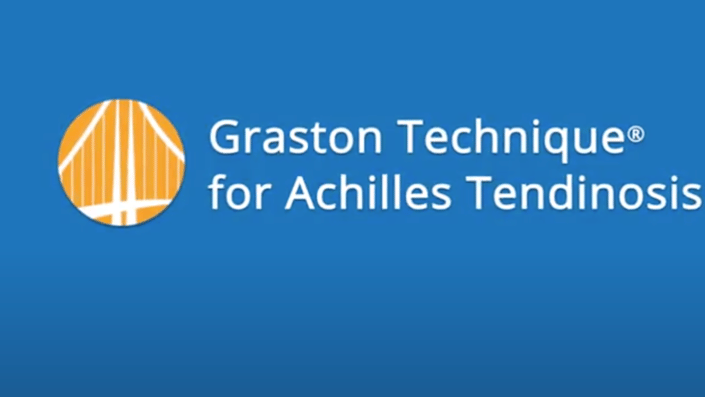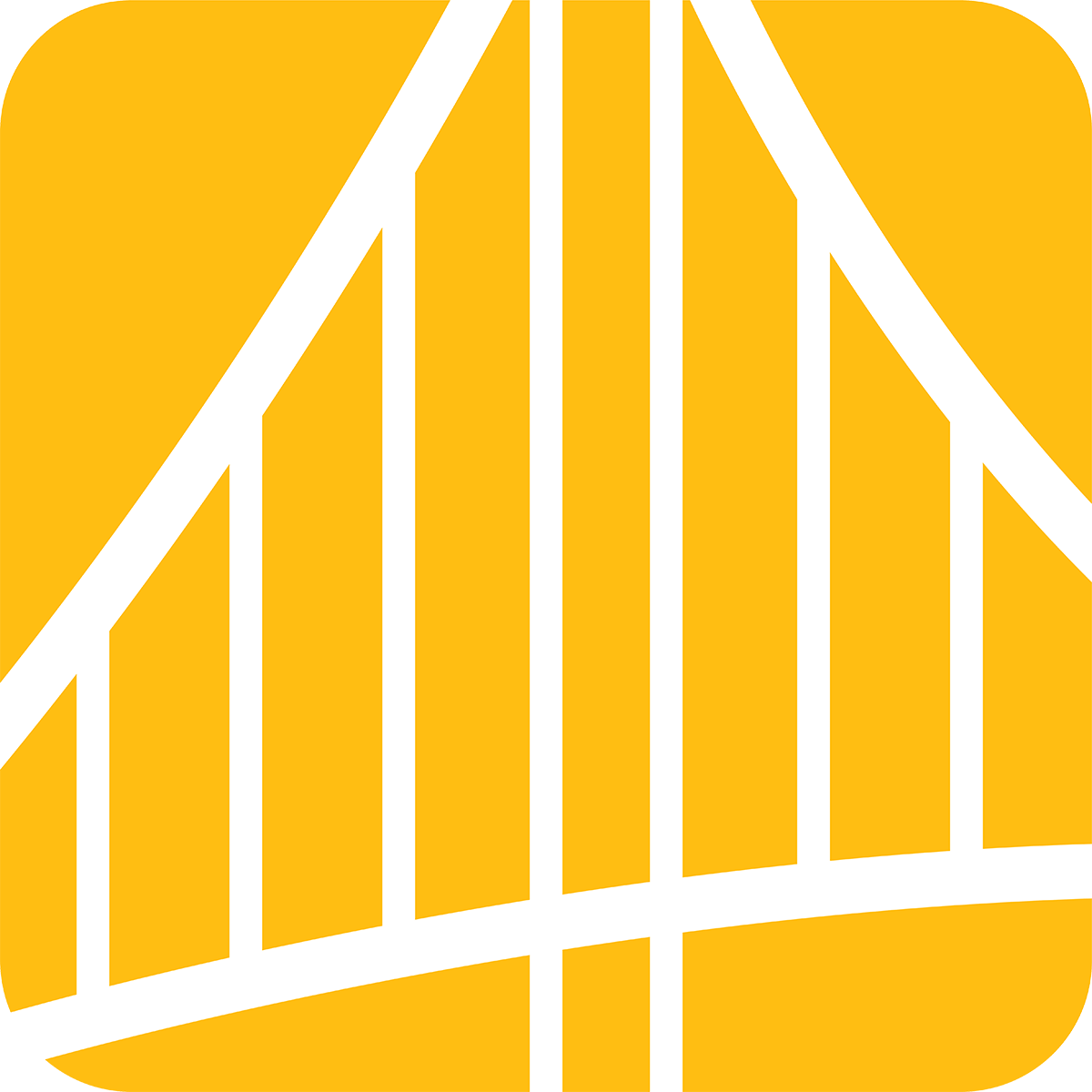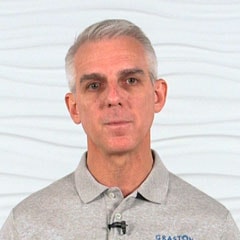Graston Technique: What PTs Need to Know, What the Evidence Shows, and How to Apply It
Achilles tendinopathy can be challenging to treat, but the right approach makes all the difference. Learn how Graston Technique® stimulates new tissue growth, enhances healing, and restores function—whether in the acute or chronic phase.
April 9, 2025
10 min. read

Instrument-assisted soft tissue mobilization (IASTM) using Graston Technique can be a practical adjunct to your plan of care when tissue remodeling and load progression are goals. Clinicians report benefits for pain, mobility, and tolerance to activity across tendinopathies and myofascial restrictions. The research base has grown over the past decade, and while results vary by condition and study design, there is enough signal to guide thoughtful use—especially when paired with progressive exercise. This article reviews what Graston Technique is, what current evidence suggests, how to dose and progress it, and a worked example you can adapt in clinic. We’ll also cover precautions, documentation tips, and outcome tracking with quick wins you can use today.
What Is Graston Technique?
Graston Technique is a branded form of IASTM that uses stainless-steel instruments with beveled edges to deliver shear and compression forces to skin and underlying fascia. The clinical intent is to modulate pain, address density/texture changes, and promote tissue remodeling so patients can resume targeted loading. A foundational body of preclinical work reports mechanobiologic effects—such as changes in fibroblast activity and collagen organization—after instrumented soft-tissue loading in animal models.¹²³⁴ These mechanistic data do not guarantee clinical benefit in humans, but they offer a rationale for pairing IASTM with progressive exercise in conditions marked by failed healing or disorganized collagen.
What Does the Evidence Say?
Systematic reviews and trials
A 2016 systematic review (IASTM—multiple tools, frequent inclusion of Graston protocols) found early support for short-term pain and range-of-motion changes, while noting small samples and variable methods.⁵
A 2019 effect-size analysis and systematic review echoed that IASTM may improve pain and ROM in the short term, with heterogeneity limiting firm conclusions.⁶
Newer reviews have tightened the picture: a 2024 BMC review focused on ROM found IASTM can increase joint ROM, particularly when baseline restriction is present.⁷ A 2025 BMC review on pain/function concluded IASTM can reduce pain with moderate certainty and improve function with low certainty across musculoskeletal conditions.⁸
Condition-specific clinical reports include a case series for chronic plantar heel pain combining Graston and stretching with meaningful improvements in pain and function measures.⁹
For shoulder mobility, an acute study in collegiate baseball players reported improved internal rotation and horizontal adduction after a single IASTM session to posterior shoulder tissues.¹⁰
What this means in practice
Across reviews, the most consistent signal is short-term pain relief and ROM gains.⁶⁷⁸ Larger, high-quality trials by condition remain limited. Clinically, your best bet is to position Graston Technique as a supporting intervention to help patients tolerate and progress the loading strategy that ultimately drives outcomes (e.g., eccentrics, heavy-slow resistance, return-to-run progressions).
How Might It Work? A Quick Mechanobiology Snapshot
Preclinical studies using instrument-assisted cross-fiber strokes on injured tendon/ligament tissue in rats show increased fibroblast proliferation, improved collagen alignment, accelerated ligament healing, and altered microvascular morphology near healing tissue.¹²³⁴ These changes suggest that controlled, instrument-delivered shear forces can influence the cellular environment that governs remodeling. While animal data can’t be over-generalized to humans, they support a clinic pattern many PTs observe: IASTM helps patients tolerate load progression by reducing symptom irritability and improving motion windows needed for quality exercise.
Indications, Precautions, and Contraindications
Common use cases
Pain-limited tendinopathies and myofascial restrictions that cap movement quality or dosage of loading
ROM caps (e.g., posterior shoulder tightness limiting IR/horizontal adduction)¹⁰
Plantar heel pain with calf/plantar soft-tissue density changes⁹
Contraindications/precautions
Peer-reviewed guidance and expert consensus highlight the following: active infection or open wound, unhealed fracture, thrombophlebitis/DVT, areas of myositis ossificans, uncontrolled hypertension, bleeding disorders/anticoagulation risk, patient intolerance, and cautious use over compromised skin or recent surgical sites.¹¹¹² Expect transient erythema; petechiae is a signal to adjust stroke, pressure, or dosage.¹¹
Always screen, obtain informed consent, and document rationale, location, instrument, stroke type, dosage, patient response, and how the technique enables the next step in the exercise plan.
Dosing, Progression, and Pairing With Exercise
Set-up and dosage
Tissue prep: Light warm-up (5–8 minutes of aerobic, active ROM, or thermotherapy) to increase tissue pliability.
Instrument & stroke: Choose an edge that matches the contour; use sweep, fan, or strum strokes aligned with the restriction. Begin with gentle scanning to localize tenderness or texture change, then apply treatment strokes with patient-tolerated pressure.
Time per region: 1–3 minutes of treatment strokes for small regions; 3–5 minutes for larger regions; reassess often. Total session time is usually 8–12 minutes across all regions you address.
Frequency: 1–2 sessions/week early on, taper as the patient self-manages with loading and home program.
Immediate reassessment: Re-check the asterisk sign (e.g., reach IR, step-down pain, first-step pain scale). If no change, modify technique or move on.
Pairing with exercise
The technique is a bridge to loading. Use the motion/pain window you create to prescribe the intervention that drives adaptation—eccentrics or heavy-slow resistance for tendinopathy, motor control under load, or graded exposure for return to running. The literature and clinical experience point to the combination of IASTM + progressive exercise as the high-value pattern.⁶⁷⁸
Documentation and Billing Notes
Many clinics document Graston Technique under CPT® 97140 (Manual therapy techniques, each 15 minutes) alongside objective measures and the functional task it enabled. Always align with payer rules and your clinic’s compliance policies.¹³
Worked Example: Graston Technique for Midportion Achilles Tendinopathy
Patient snapshot
Recreational runner, 38, with 12-week history of midportion Achilles pain. Morning stiffness, pain 4–6/10 with hills, limited single-leg calf raises, VISA-A 60/100. Negative red-flag screen; no anticoagulants; skin intact.
Plan of care (first 4–6 weeks)
Education & load plan: Reduce hill running and plyometrics for now; maintain fitness with cycling or flat easy runs if symptoms allow.
IASTM application (Graston Technique):
Position: Prone with foot off table; knee extended and then flexed to bias soleus.
Scan: Light sweeping strokes along gastrocnemius–soleus complex, Achilles midportion, and plantar fascia to identify tender bands.
Treatment strokes (per region 1–3 minutes):
Longitudinal sweep along tendon midportion at tolerated pressure
Cross-fiber strum at the most symptomatic 2–3 cm segment
Fan strokes over distal calf if density/guarding limits dorsiflexion
Total IASTM time: ~8–10 minutes; reassess ankle DF and step-down pain.
Progressive exercise immediately after IASTM:
Weeks 1–2: Seated and standing heel raises to tolerance; isometric mid-range holds (30–45 seconds × 4–5) if pain limits isotonic work
Weeks 2–4: Eccentric heel drops from step (knee straight and bent) or heavy-slow resistance on leg press/calf raise machines as tolerated
Weeks 4–6: Introduce tempo running or gentle hills when single-leg calf raises reach ≥25 reps pain ≤3/10
Home program: Daily calf strengthening, ankle DF self-mobs, and tissue self-care with lacrosse ball for plantar fascia as tolerated.
Outcome tracking: NPRS for first-step pain, VISA-A every 2–3 weeks, single-leg calf-raise count, and run-time without symptom flare.
Why this sequence?
Case-level and experimental work show short-term pain/mobility changes with IASTM and mechanobiologic effects in connective tissue after instrumented loading.¹²³⁴⁵⁶⁷⁸⁹ These windows help the patient complete the volume and intensity of calf loading needed for tendon capacity changes.
Practical Tips You Can Use Tomorrow
Target the limiter. Treat and retest the movement that blocks progression (e.g., posterior shoulder IR, first-step pain with plantar heel pain, DF for squatting).⁹¹⁰
Less is more. Short bouts with frequent reassessment often outperform long sessions. If the asterisk sign doesn’t change, change something.
Pair with strength. Schedule IASTM early in the session, then load the region while symptoms are quieter—carryover matters.⁶⁷⁸
Watch the skin. Erythema is expected; petechiae means back off. Document patient response and modify pressure or stroke.¹¹
Keep outcomes visible. Track a patient-reported pain measure, a function/participation metric, and one tissue capacity metric. Adjust weekly.
Graston Technique is a tool—not the plan. Use it to modulate symptoms and open a motion window, then spend your time on the progressive loading that restores capacity. Current evidence supports short-term improvements in pain and ROM, with variable effects on function by condition. Thoughtful screening, measured dosing, and tight pairing with exercise give it a clear place in a modern PT program.⁵⁶⁷⁸⁹¹⁰
References
Davidson CJ, Ganion LR, Gehlsen GM, Verhoestra B, Roepke JE, Sevier TL. Rat tendon morphologic and functional changes resulting from soft tissue mobilization. Med Sci Sports Exerc. 1997;29(3):313-319. https://pubmed.ncbi.nlm.nih.gov/9139169/ PubMed
Loghmani MT, Warden SJ. Instrument-assisted cross-fiber massage accelerates knee ligament healing. J Orthop Sports Phys Ther. 2009;39(7):506-514. https://pubmed.ncbi.nlm.nih.gov/19574659/ PubMed
Loghmani MT, et al. Instrument-assisted cross-fiber massage increases tissue perfusion and alters microvascular morphology in the vicinity of healing knee ligaments. BMC Complement Altern Med. 2013;13:240. https://pmc.ncbi.nlm.nih.gov/articles/PMC3852802/ PMC
Kim J, Sung DJ, Lee J. Therapeutic effectiveness of instrument-assisted soft tissue mobilization for soft tissue injury: mechanisms and practical application. J Exerc Rehabil. 2017;13(1):12-22. https://pmc.ncbi.nlm.nih.gov/articles/PMC5331993/ PMC
Cheatham SW, Lee M, Cain M, Baker R. The efficacy of instrument assisted soft tissue mobilization: a systematic review. J Can Chiropr Assoc. 2016;60(3):200-211. https://pmc.ncbi.nlm.nih.gov/articles/PMC5039777/ PMC
Seffrin CB, Cappaert TA, Bacharach DW. Instrument-Assisted Soft Tissue Mobilization: A Systematic Review and Effect-Size Analysis. J Athl Train. 2019;54(7):808-821. https://pmc.ncbi.nlm.nih.gov/articles/PMC6709755/ PMC
Tang S, et al. The effectiveness of instrument-assisted soft tissue mobilization on range of motion: systematic review. BMC Musculoskelet Disord. 2024. https://bmcmusculoskeletdisord.biomedcentral.com/articles/10.1186/s12891-024-07452-8 BioMed Central
Tang S, et al. The effectiveness of instrument-assisted soft tissue mobilization on pain and function in patients with musculoskeletal disorders: a systematic review. BMC Musculoskelet Disord. 2025. https://bmcmusculoskeletdisord.biomedcentral.com/articles/10.1186/s12891-025-08492-4 BioMed Central
Looney B, Srokose T, Fernández-de-las-Peñas C, Cleland JA. Graston instrument soft tissue mobilization and home stretching for the management of plantar heel pain: a case series. J Manipulative Physiol Ther. 2011;34(2):138-142. https://pubmed.ncbi.nlm.nih.gov/21334547/ PubMed
Laudner K, Compton BD, McLoda TA, Walters CM. Acute effects of instrument-assisted soft tissue mobilization for improving posterior shoulder ROM in collegiate baseball players. Int J Sports Phys Ther. 2014;9(1):1-7. https://pmc.ncbi.nlm.nih.gov/articles/PMC3924602/ PMC
Cheatham SW, Baker R. Instrument-assisted soft-tissue mobilization: a commentary on clinical practice guidelines. Int J Sports Phys Ther. 2019;14(4):670-682. Contraindications/precautions summary. https://pmc.ncbi.nlm.nih.gov/articles/PMC6670063/ PMC
Cheatham SW, et al. International Expert Consensus on IASTM Precautions and Contraindications: A Modified Delphi Study. Int J Sports Phys Ther. 2025. https://pmc.ncbi.nlm.nih.gov/articles/PMC11941819/ PMC
American Medical Association. CPT® code 97140: Manual therapy techniques, each 15 minutes. https://www.ama-assn.org/practice-management/cpt/cpt-code-97140-manual-therapy-techniques-each-15-minutes American Medical Association
Below, watch Mike Ploski demonstrate eccentric loading and the Graston Technique in a short video from his and Nathan Hinkeldey's course, "Achilles Tendinosis and Graston Technique®: Evidence-Based Treatment."








